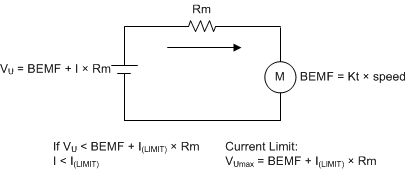SLVSDN2E January 2018 – March 2021 DRV10974
PRODUCTION DATA
- 1 Features
- 2 Applications
- 3 Description
- 4 Revision History
- 5 Pin Configuration and Functions
- 6 Specifications
-
7 Detailed Description
- 7.1 Overview
- 7.2 Functional Block Diagram
- 7.3 Feature Description
- 7.4 Device Functional Modes
- 8 Application and Implementation
- 9 Power Supply Recommendations
- 10Layout
- 11Device and Documentation Support
- 12Mechanical, Packaging, and Orderable Information
Package Options
Mechanical Data (Package|Pins)
Thermal pad, mechanical data (Package|Pins)
Orderable Information
7.3.5 Soft Current-Limit
The current-limit function provides active protection for preventing damage as a result of high current. The soft current-limit does not use direct-current measurement for protection, but rather, uses the measured motor resistance (Rm) and motor velocity constant (Kt) to limit the voltage applied to the phase (U) such that the current does not exceed the limit value (I(LIMIT)). The soft current-limit scheme is shown in Figure 7-12 based on the calculation in Equation 4.
The soft current-limit is only active when in normal closed-loop mode and does not result in a fault condition nor does it result in the motor being stopped. The soft current-limit is typically useful for limiting the current that results from heavy loading during motor acceleration. The I(LIMIT) current is configured by an external resistor (R(CS)) as shown in Table 7-1.
 Figure 7-12 Current Limit
Figure 7-12 Current LimitUse Equation 4 to calculate the I(LIMIT) value.

Table 7-1 can be used to determine the I(LIMIT) value.
| R(CS) [kΩ](1) | I(LIMIT) [mA] |
|---|---|
| 7.32 | 200 |
| 16.2 | 400 |
| 25.5 | 600 |
| 38.3 | 800 |
| 54.9 | 1000 |
| 80.6 | 1200 |
| 115 | 1400 |
| 182 | 1600 (1500 during align) |
The soft current-limit is not correct if the motor is out of phase with the commutation control logic (locked rotor). The soft current-limit is not effective under this condition.